We didn’t want to write yet another “9 amazing pillar pages you should totally copy” article. You’ve seen those in the SERP. They list a bunch of URLs with zero context.
We picked just three pillar pages. But we went deep. Like, content-nerd deep.
We interviewed a few content experts behind these high-performing pages to understand:
- How they structure their pillar pages to satisfy search intent
- How they link to supporting content
- What actually makes these pages perform
And, you’ll also get a behind-the-scenes look at one of our pillar pages that’s consistently delivered solid results.

Let’s dive in. You won’t need a list of 10 when you’ve got 3 that actually teach you something.
By the end, you’ll know exactly how to create a pillar page that drives traffic and conversions.
Table of Contents
Let’s Align: What is a Pillar Page?
Recently, we created a survey of the best pillar pages. We asked our users to share their best pillar pages to kickstart the project.
To our surprise, we discovered that many site owners don’t know what a pillar page is. Some shared their home page, some shared a long-form blog post, while others sent their product’s landing page.
You may be in the same shoes as these users. Don’t worry; we’ve got you covered.
A pillar page is a central page that provides an overview of a main topic and links to sub-pages. It is a central hub for topic clusters, linking to in-depth resources on specific subtopics.
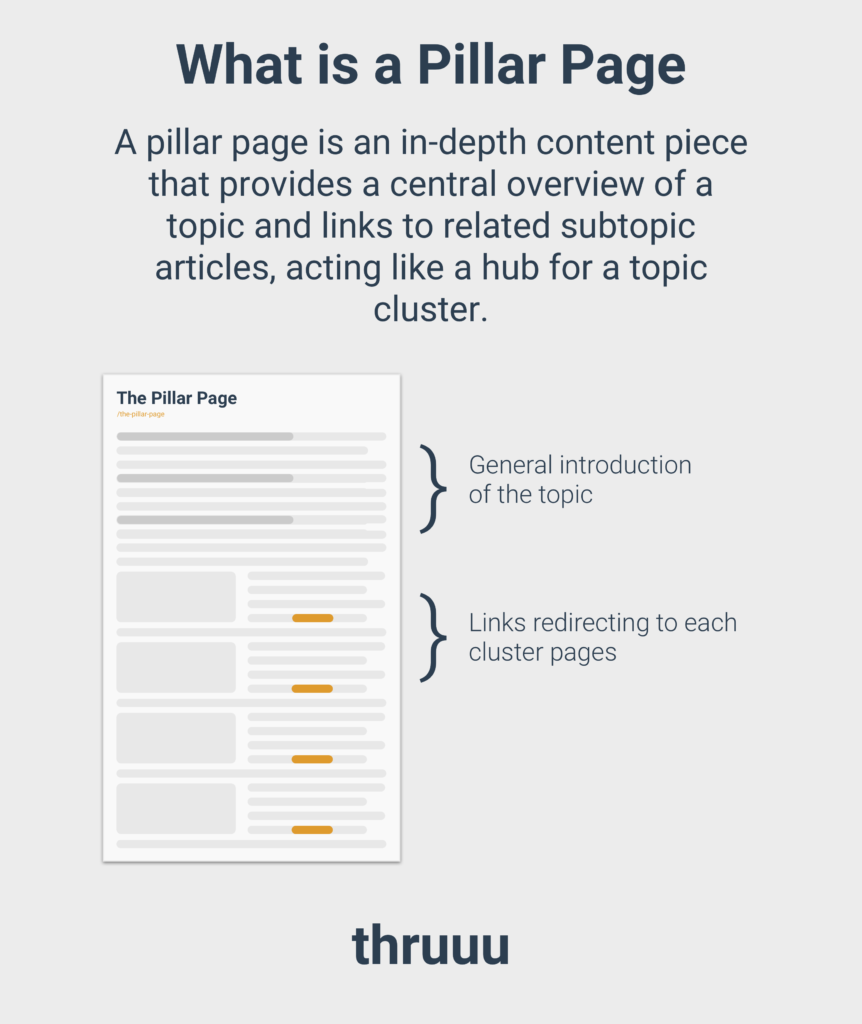
It’s designed to link out to and receive links from cluster pages. Together, they form a content ecosystem that tells search engines and users, “Hey, we’re the authority on this topic.”
Simply put, a pillar page covers a topic broadly, while its cluster pages focus on detailed aspects.
Let’s see some pillar page examples that can serve as your template.
Examples of Successful B2B Pillar Pages
We will cover three pillar pages and share the unique insights from the SEO experts behind these pages.
These pillar page examples are B2B content, but you can use them as prototypes for creating B2C pillar pages.
Here are our top three pillar page examples:
Example 1 – A Guide About Topic Cluster Strategy
Our tool, thruuu, has a topic cluster feature that groups keywords by search intent and creates data-driven topic clusters.
We aim to become an authority on the subject of “topic cluster,” so we created a pillar page and a hub of resources about topic cluster content strategy.
We created the pillar page as a solution walk-through that satisfies a reader’s search intent.
The pillar page features a link to cluster pages covering different aspects of a topic cluster content strategy.

We also followed Google’s anchor text guidelines for the interlinks.
The link texts are descriptive and relevant to the pages they are on and link to. A small paragraph next to each anchor text tells users the context of the linked pages.

The cluster pages also link to one another and to the pillar page. This strategy helps search engine bots understand the site structure and content hierarchy.

We also included easy-to-understand branded infographics that explain the basics of a topic cluster strategy and how to create one.
Again, the pillar page features detailed step-by-step tutorial videos that walk readers through creating a topic cluster for themselves.
We also made the pillar page accessible from the website’s top navigation and footer. Anyone who lands on our site can easily access it and see us as an authority on that topic.

Key Takeaways:
- The pillar page features a link to cluster pages that cover different aspects of the topic. Note: We avoided keyword stuffing by only including cluster pages that fit into the flow of the pillar page
- We used relevant internal links to boost the pillar page structure
- We prioritized search intent satisfaction. The pillar page starts with the what articles, then how articles, best tools articles, and tutorial videos.
- We included appealing and detailed visuals that improved readability
You can explore the pillar page here.
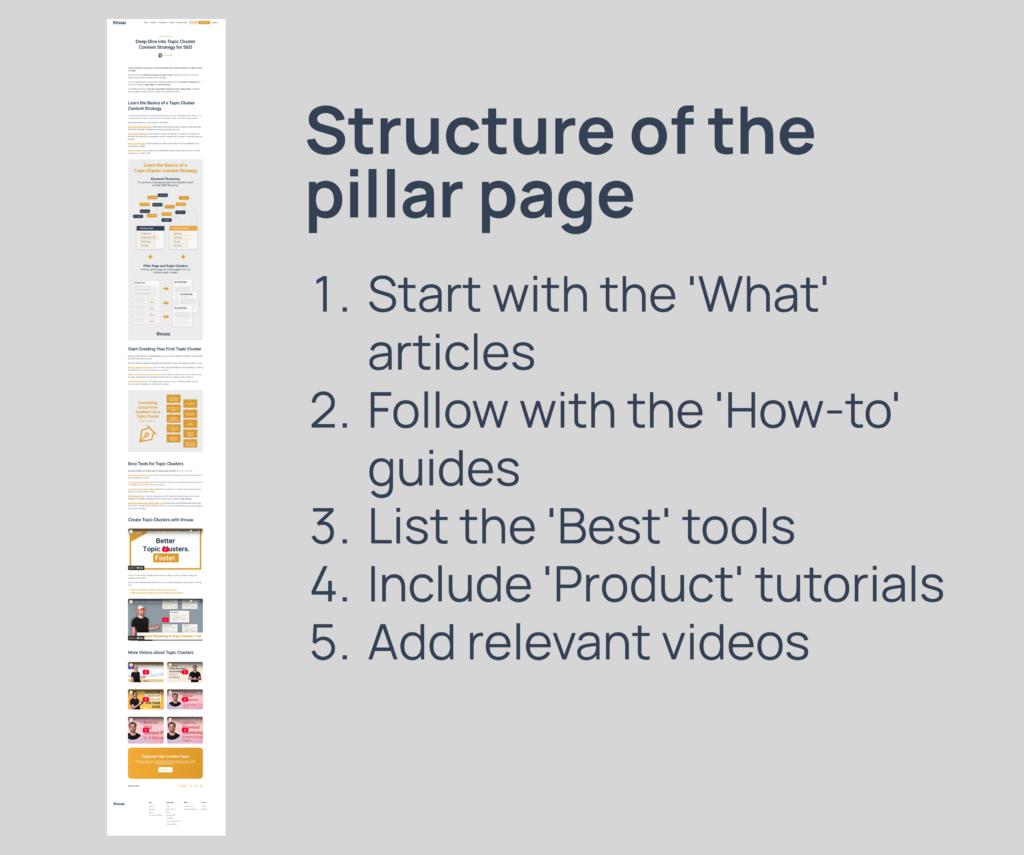
Example 2 – Pillar Page About B2B SaaS SEO
Stratabeat created a pillar page on B2B SaaS SEO that stands out for prioritising information gain.
The reading flow is excellent, and the article reads like a coffee chat with the readers.
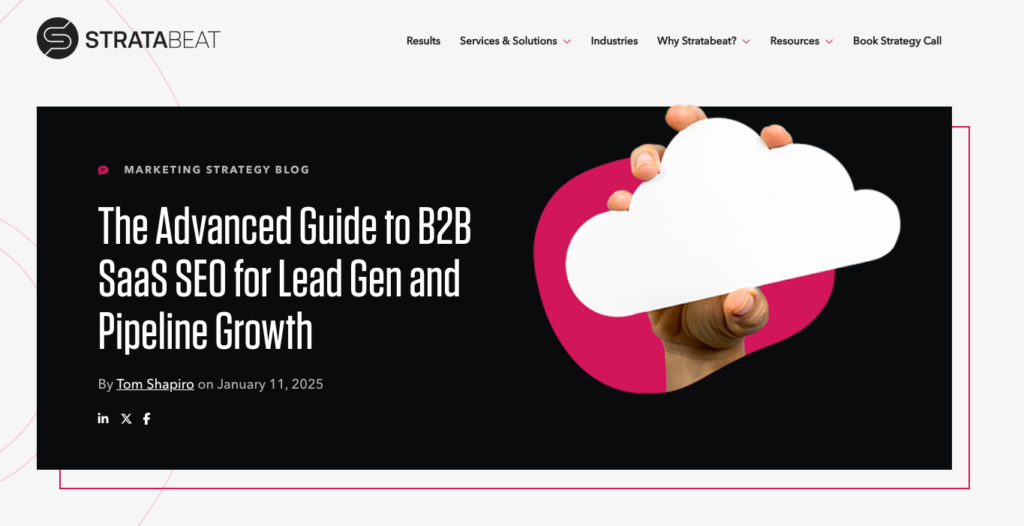
This pillar page is well-designed and includes visuals that keep readers glued to their screens.
Most importantly, it highlights key blog posts to read with compelling CTAs after each aspect of the topic.
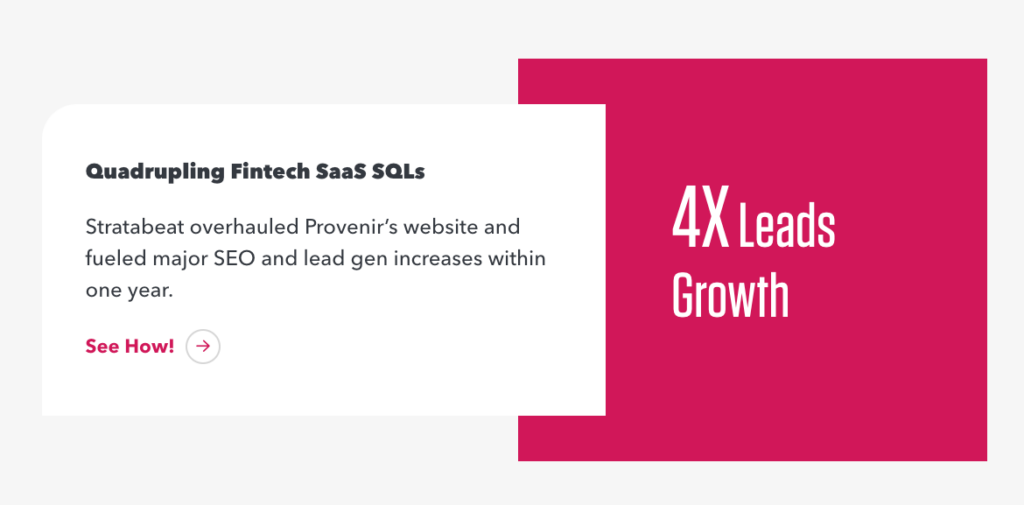
You should implement this strategy to increase your site’s dwell time and user experience. By reading the linked page, your readers will fully understand that specific aspect of the topic.
We asked Tom Shapiro, CEO at Stratabeat, about the uniqueness of this pillar page.
He said,
“The page is comprehensive, covering different facets of the topic (well beyond what others on Google page one provide). Plus, the content is up-to-date, speaking to recent developments in the industry.
In addition, the page includes specific real-world examples, which helps the content stand out and be differentiated while providing tangible value to the reader.
As a result, this pillar page currently ranks #1 in Google for the primary keyword “b2b saas seo” and ranks for 16 relevant SEO keywords within the top 30 positions in Google.”
Stratabeat implemented proper internal linking on this pillar page. The link texts were descriptive and relevant to the pillar page and the pages linked to.
Interestingly, they linked to different resources, such as blog posts to educate, case studies to convince, and reports to show expertise.

They also linked to relevant pages on their sites, including B2B blogging, B2B marketing agency, B2B SEO agency, B2B content marketing agency, B2B content strategy agency, B2B SaaS marketing agency, and more.
These pieces of content are also semantically related and make perfect sense within the context of the pillar page, as they highlight SEO strategies for B2B SaaS.

We discovered these links using our free link extractor. This tool extracts all the links on a page and presents them by their anchor texts, URL, external/internal, and Rel.
Let’s wrap up with Tom Shapiro’s #1 best practice for creating a high-performing pillar page.
“Information gain is critical to developing high-powered pillar pages. Ensure that your content includes experience- or expert-based examples and covers the topic more in-depth than competitors.”
Key Takeaways:
- The pillar page is a comprehensive guide
- There are internal links to different content resources, including blog posts, case studies, reports, and more
- Each section of the pillar page concludes with a CTA to the cluster page
- The pillar page has a good content flow with compelling visuals to improve readability
Example 3 – SEO Academy Hub
Here is another pillar page by Siteguru on SEO.
This pillar page is unique in its format. They created a great SEO Content Hub following a content library model.

The primary pillar page lists all the topics with their subpages.

You have a category hub featuring cluster pages when you click on any pillar topic.

Then, each cluster page covers an in-depth subset of the category and links to other cluster pages and categories.
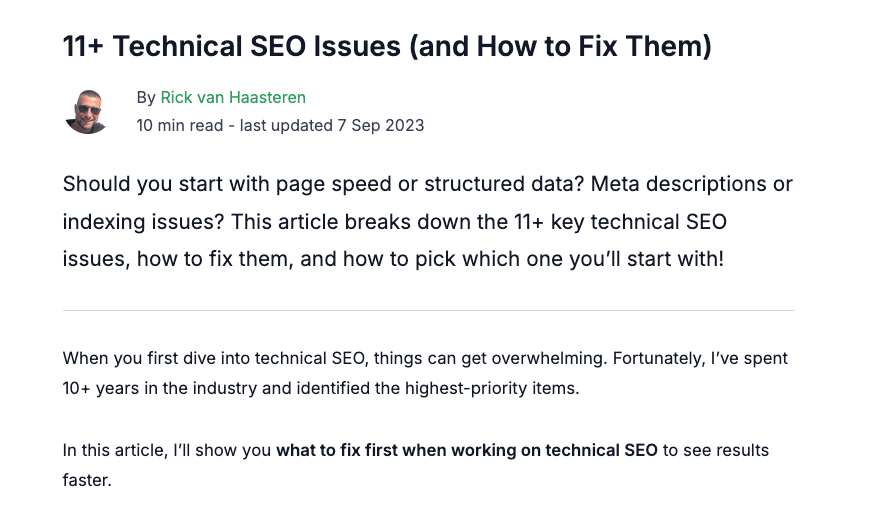
Lana Rafaela Cindric, Content and Marketing Manager at SiteGuru, shared what is unique about the cluster page above on technical SEO issues.
“To become the authority on technical and on-page SEO, we’ve set up this page as the central actionable resource for people struggling with specific technical SEO issues.
As they explore the page, they’ll find the section explaining the issue and linking to a walkthrough of how to solve it.
In terms of performance, it’s proven to be a great lead funnel. People will see this article when searching for their typical SEO issues, get more knowledge, and then sign up for our product to stay on top of their SEO opportunities”
A navigation element redirects to the next cluster page at the end of each page.

The footer of each cluster page also links to all other categories and cluster pages. This internal linking strategy reinforces the content structure and sends link juice among the pages.

Lana provides their secret tips for creating high-performing pages.
She said,
“Keep it actionable. You never want the lead to go through thousands of words in the hope of finding the advice that will help them in the next five minutes.
Have a robust heading organization, so they can easily click through and find what they need.
Finally, remember: no one has the time. Can you provide the solution in 5 minutes or less? If so, you’ve got a winning page.”
Key Takeaways:
- The pillar page is a content library that features a primary hub, categories, and cluster pages
- There is a solid internal linking structure that connects the pillar page to the categories and cluster pages
- There is a navigation element at the bottom of the cluster pages and a link to other clusters at the footer of each cluster page.
What impact will creating a pillar page have on your site?
Let’s see a few benefits!
Benefits and Results of Implementing Pillar Pages
A pillar page isn’t another random content asset to fill your blog. It’s like a treasure chest that keeps giving.
Here are some of the fringe benefits that come with a top-notch pillar page:
Establishing Authority in Your Niche
A pillar page makes your site the go-to center on a topic. It allows you to cover a topic comprehensively and strengthen your topical authority.
Again, Google reinstated in its creating helpful content checklist that its algorithm loves content that provides a substantial, complete, or comprehensive description of a topic.
Enhancing User Experience and Navigation
Pillar pages help you build a solid content structure with cluster pages interconnected by internal links.
This allows visitors to easily find information about a specific topic, leading to a better user experience.
Boosting SEO and Organic Traffic
When search engines see your site as an authority on a topic, they reward you with better ranking.
For instance, Stratabeat’s pillar page on B2B SaaS SEO ranks #1 on the Google result page for the primary keyword “b2b saas seo”. It also ranks for 16 other keywords within the top 30 positions on SERP.
Our pillar page on topic cluster content strategy and its cluster pages also made us a fortune. After a few months of publishing, they boosted our organic traffic and sign-ups.

Thanks to this strategy, we also rank well for one of our money pages, “keyword clustering tools.”
Let’s see how to create your own pillar page.
Create your First Pillar Page
Creating a pillar page isn’t rocket science. You can follow a list of tasks and get results similar to those mentioned above.
Ready to create yours?
Follow these steps to create a pillar page that increases your site’s perceived value:
Start With a Core Topic
Choose a topic relevant to your industry and brainstorm broad content ideas. We recommend you choose a topic you want to be known for.
For instance, we created a pillar page on the topic cluster strategy to increase our authority and push our topic cluster tool.

Do Keyword Research
Perform keyword research to find long-tail and short-tail keywords around your core topic. You should also discover synonyms and keywords related to your core topic.
Then, use a tool to group your keywords into topic clusters.
Interestingly, you can automate these tasks effectively in a few minutes with the thruuu topic clustering tool.
This tool groups your keywords by search intent and SERP similarities into topic clusters. Interestingly, it also finds new ideas to solidify your topic clusters.
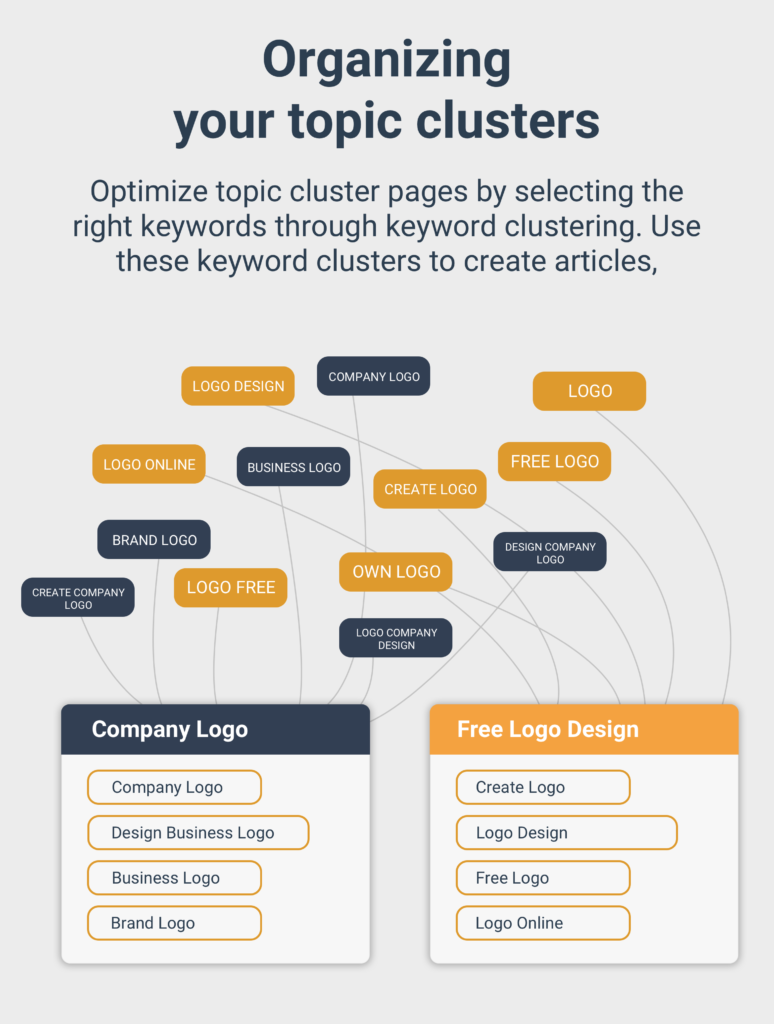
Analyse SERPs to Understand Intent and Structure Cluster Content Accordingly
Analyze the SERP to understand the search intent and create your cluster pages to satisfy the purpose.
Your cluster pages should be like a solution guide that walks your readers from their problem to the solution.
Create Cluster Pages First
Create SEO content briefs using your primary and secondary keywords for each cluster.
You can use the thruuu content brief generator to speed up the process.
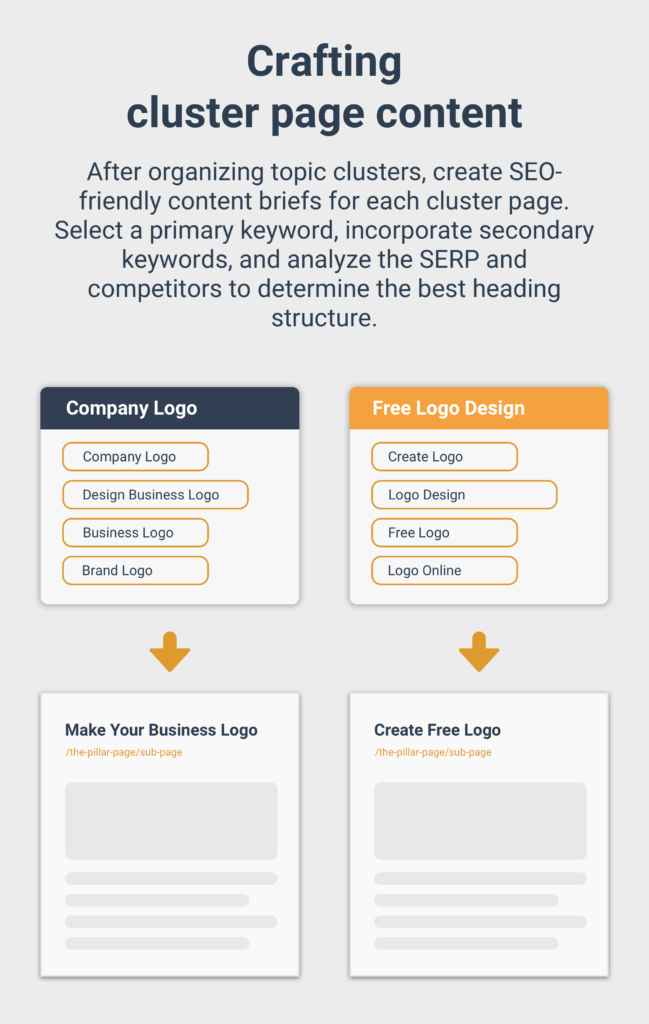
Interlink Cluster Pages
Link your cluster pages to each other with descriptive anchor texts. Internal linking solidifies your content structure and tells search engines about the relevance between two pages.

Build the Pillar Page Last
Your pillar page should be the last card that wins the game.
It should be detailed, comprehensively covering the topic and linking to cluster pages.
We recommend you create your pillar page last for proper internal linking structure.
You want to ensure that your pillar pages link to subsidiary pages that cover different aspects of the topic in depth and that they all link back to the pillar page.

Ensure Clear Formatting
No one wants to read a wall of text fused without breaks, spacing, or structure.
Use short paragraphs for easy comprehension. Also, use subheadings, bullet points, or numbered lists to break down the content to make it easy to scan.
Read our detailed guide on topic clusters for more context on creating pillar and cluster pages.
Common Mistakes to Avoid When Creating a Pillar Page
Avoid these mistakes to make your pillar page stand out:
- Neglecting user intent and content quality
- Underutilising internal links
- Failing to update and refresh content regularly
- Keyword cannibalization: This happens when multiple pages on your website target the same keyword and search intent.
- Poor UX and formatting
- No clear call to action
thruuu unique features help you avoid these mistakes effortlessly.
The topic clustering tool groups your keywords by SERP similarities for easy search intent satisfaction. This grouping strategy prevents keyword cannibalization (no two clusters will target similar search intent).
Empower Your Content Team
Our end-to-end content optimization solution empowers your team to crack the Google algorithm, craft exceptional content, and achieve remarkable organic search results.
